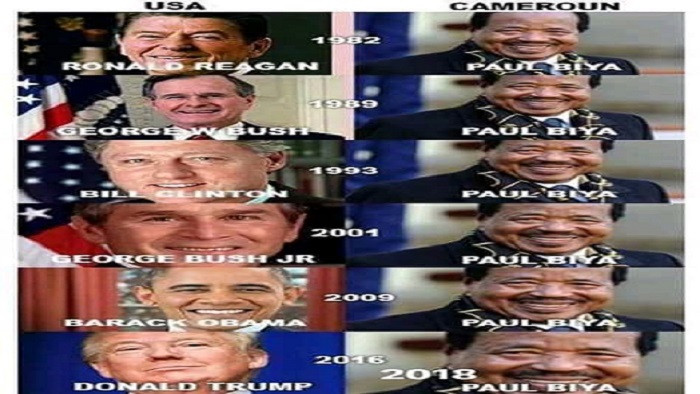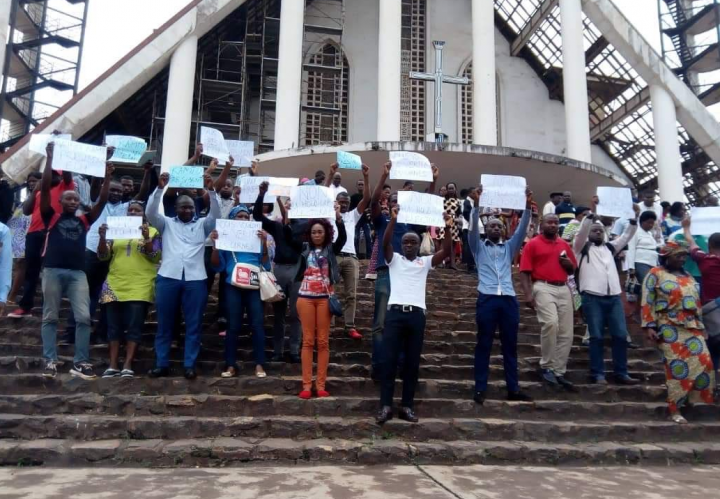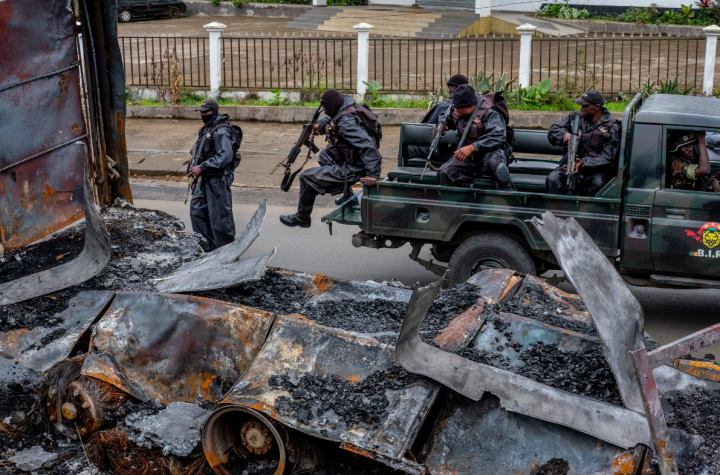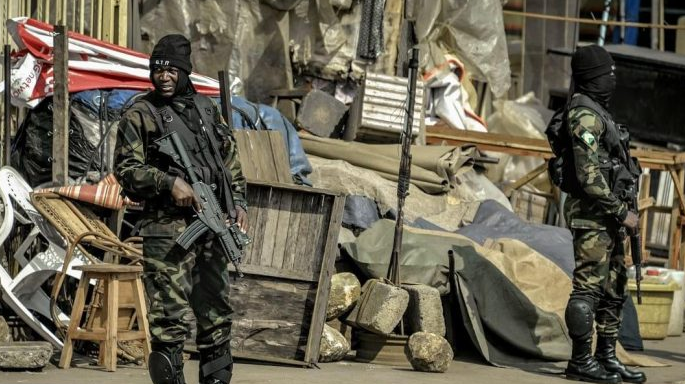Paul Biya’s never-ending presidency
On 22 October (weeks after the polls opened on 7 October), it was finally confirmed that 85-year-old President of Cameroon, Paul Biya, will serve another term in office. Voter turnout was very low; and in the urban centres of Douala and Yaoundé, the leadership of the working class was nowhere to be seen – despite widespread hatred of the Biya regime. Moreover, violent unrest in the Anglophone regions made any kind of democratic process there impossible, and tit-for-tat skirmishes between state troops and separatists have aroused fears of a new civil war that could plunge the country into barbarism.
This was an election marked by fraud, violence and voter apathy: all of which played a role in the outcome. Despite the unpopularity of the Biya government, the masses had no faith in the weak, divided opposition candidates, none of whom offered a credible alternative to the ruling Cameroon People’s Democratic Movement (CPDM). Nor did they pose any solution to the economic problems of underemployment and poverty, resulting from falling oil prices, the burden of foreign debt and endemic corruption.
Biya currently maintains his grip on power thanks to the CPDM’s total dominance of the state apparatus; economic and military support from imperialist governments (particularly France and America); and by buying off traditional tribal leaders – the reactionary “elites” who command significant authority among Cameroon’s more backward, rural layers. Most importantly, Cameroon’s working class and peasantry lacked a political leadership capable of taking advantage of people’s desire for change. However, president Biya is sitting on a powder keg, and his increasingly repressive efforts to hold onto power and quell the Anglophone question are provocations to the masses.
A farcical election
When the results were released, Biya rejected calls for a re-run from opposition parties, insisting the elections were free and fair. He went so far as to send fake representatives from Transparency International to be interviewed on the state-run Cameroon Radio Television (CRTV) and attest the elections were conducted justly.
This stunt was a capstone to a farcical election, in which Biya took the majority of votes in all but one of Cameroon’s 10 regions, losing out to Maurice Kamto of the Cameroonian Resistance Movement (MRC) by a small margin in the Littoral region: home to the economic capital, Douala. Despite prematurely declaring victory, Kamto claimed just 14.2 percent of the official vote share. Joshua Osih, candidate of the main opposition party (the Social Democratic Front) came fourth, with 3.35 percent. After the official results were announced, hundreds of Kamto’s (mostly young) supporters in Douala mounted a furious protest against Biya, complaining that their candidate had been cheated. This and smaller protests in Yaounde and Bafoussam were quickly contained by the police, with witnesses reporting that protesters were beaten and dragged through the mud.
After the results, hundreds of opposition supporters mounted a furious protest against Biya
Doubtlessly, Biya rigged the race, making full use of his control of the media to ensure that all political opposition was pushed to the sidelines. In 2018, the government expanded its surveillance networks across social media, to shut down opposition campaigns and promote its own propaganda. The CPDM also used a tactic of setting up over 20 phony “opposition” parties, which all switched their support to the incumbent at the last minute. Biya was so confident of victory that he barely bothered to campaign, organising only one rally in the northern region.
Additionally, there are reports that opposition candidates were harassed and thrown out of polling stations by the CPDM’s goons. The CRM has claimed that 42 people, including party officials, were arrested over the course of the election and are still being detained. Among these is Michele Ndoki: a lawyer who defended Kamto at the constitutional council after he accused Biya of fraud and ballot-stuffing in favour of the CPDM. Biya also co-opted and bribed tribal leaders to whip the vote in the more backward layers of Cameroon’s 45 percent rural population.
However, most telling of all is the fact that official voter turnout was 53 percent, compared to 68 percent in 2011 and 80 percent in 2004, revealing a lack of enthusiasm for any of the candidates. As one voter quoted in Reuters put it: “I voted for the opposition even though I did not trust them.” The low participation is also explained by the fact that tens of thousands of people were simply unable to take part due to insecurity in English-speaking Cameroon, in which the separatists aggressively enforced an election boycott. As a result, voter turnout in the country’s two Anglophone regions was as low as 5 percent, according to the International Crisis Group.
Weak and divided opposition
Cameroon is an extremely diverse and divided country. Aside from the Francophone and Anglophone question, it also comprises numerous ethnic groups, including the Bamileke and Bamoun (considered the economically dominant ethnicities); as well as Beti, Makaa, Fulani and Kirdi. These communities all have traditional tribal leaders and loyalties that Biya has historically exploited to the full. Without a class movement to cut across these lines, ethnic and national divisions resulted in a weak and divided opposition, with the anti-Biya vote split between eight presidential candidates, most of whom represented different regional bases rather than presenting distinct political programmes.
The ruling CPDM party is a bourgeois, Francophone outfit that has been in power since Cameroon gained independence from the French in 1960. The party and its then-leader, Ahmadou Ahidjo, were installed by the French authorities (originally as the Cameroon National Union) to preserve their interests in the country and repress radical, Anglophone independence parties like the UPC. It has maintained an iron grip on power ever since. It dominates the national assembly (with 148 out of 180 seats) and continues to play the role of loyal servant to (particularly French) imperialism. The CPDM and Biya (who assumed power in 1982) are deeply unpopular amongst Cameroonians, with a poll conducted by Nkafu Policy Institute putting the president on a 30 percent approval rating.
However, the opposition parties are even less popular. The CRM (which received 12.65 percent approval in the poll cited above) was founded in an abortive attempt to unify the anti-Biya vote across ethnic, language and class lines. Its 2008 founding document, “Visions of Society” is a vague and confusing jumble of nationalist, populist and liberal ideas, with no clear political or economic programme. It promises “modernisation”, an end to “right and left” divisions in politics and the promotion of “traditional values”. The document also espouses a neoliberal, anti-worker agenda. It proposes lengthening work days, lowering wages and introducing more “flexible” labour, to make the Cameroonian economy more competitive.
The CRM candidate, Kamto (an Anglophone academic, lawyer and former minister), was hoping for support from his home region in the west, the Anglophone far-north and the cities in the south (including Douala and Yaoundé). However, the Biya government has long since bought off the tribal chiefs in the north and the CRM’s vote was split with the SDF in the west. More importantly, despite populist promises to “resolve the Anglophone question” and “modernise” Cameroon’s crumbling infrastructure, the party’s neoliberal programme failed to galvanise the working class or peasantry, and its support was limited to the urban petty-bourgeoisie.
The SDF has historically been the main opposition party in Cameroon. It was founded after the introduction of multi-partyism, following a bloody political struggle in the 1990s. It traditionally had a strong Anglophone base. However, the SDF has gravitated away from Anglophone liberation in recent years, moderating its position in an attempt to broaden its appeal amongst Francophones (though not by reaching out to Francophone workers with economic reforms.) While it originally stood for succession, the party is now officially in favour of a four-part, federal state. This has angered the party’s Anglophone base, and driven many of them into the armed separatist struggle. Biya has further undercut support for the SDF by playing divide and rule between Anglophone elites in the southwest and the party’s political leaders in the northwest.
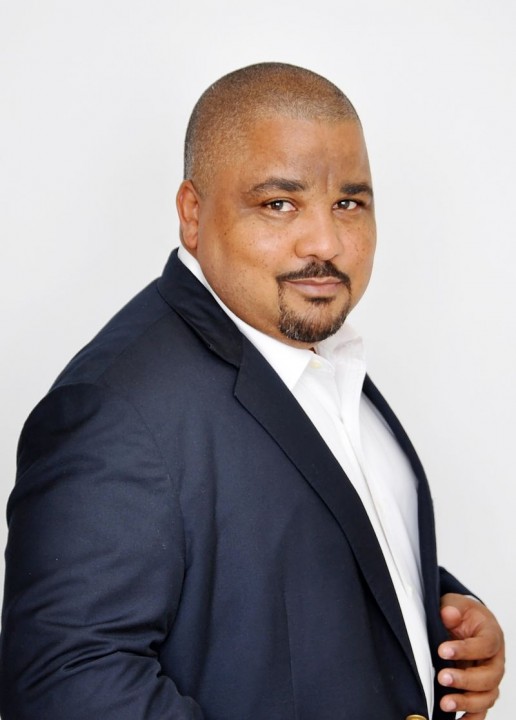
Joshua Osih of the main opposition party (SDF) received 3 percent of the vote share, compared to 11 percent for the SDF in the last elections
Despite nominally representing an Anglophone voice in the national assembly, the SDF is a shadow of its former self and commands little authority amongst the masses in either the French or English-speaking regions. Its vote share collapsed from 11 percent in 2011 to 3 percent this time around. It lost millions of votes due to the record-low Anglophone turnout, and received half the votes of third-place candidate Cabral Libii: a liberal, bourgeois lawyer with a sizable social media following but no actual policies.
Moreover, despite belonging to the Socialist International, the SDF was never a workers’ party in any practical sense. It is based largely on the urban middles classes (particularly teachers and civil servants), and in its early years entirely focused on democratic demands against Biya’s repressive regime rather than fighting for economic or social reforms for Cameroonian workers and peasants. The party’s 1990 “Constitution and Manifesto” and 1991 “Proposals on Devolution of Power” prominently enshrined a free market economy and the right to private property. Their 2018 presidential candidate is a business owner who has had relations with Biya: renting the president and his family private aircraft via one of his companies. This only reveals that the SDF and Biya are agents of the same ruling class. Unsurprisingly, the SDF utterly failed to exploit the simmering hatred for the status quo in these elections.
In despair at the hopeless opposition, ordinary people are drawing increasingly desperate conclusions. In Douala and Yaoundé, dozens of young people interviewed by the Crisis Group prior to this year’s elections stated that: “since the government and opposition are both against us, we might as well spoil everything so that nobody wins”, and that Cameroonians must “make themselves heard by doing what the Anglophones are doing.” This is now the mood on the streets: the potential for civil unrest is building even as Biya tightens his chokehold.
Economic crisis
Biya’s increasingly repressive grip on power must be understood in the context of Cameroon’s ongoing economic crisis, that places him on an increasingly unstable footing. GDP growth in Cameroon is falling and the cost of living is increasing. The main culprit in recent years has been volatile oil prices, which despite bouncing back to $64.60 a barrel in 2018, fell as low as $44.00 a barrel in 2016. Cameroon’s oil (mostly off the coast of the Anglophone southwest) accounts for nearly 40 percent of the country’s exports, compared to 30 percent for agricultural products. The dips in oil prices have wreaked havoc on the lives of the Cameroonian masses and have deepened resentment against the regime.
In general, Cameroon’s economy is very underdeveloped. 70 percent of the country’s workforce is employed in agriculture, compared to only 13 percent in industry and 17 percent in services. While the government has attempted to modernise agricultural production in recent years, millions of Cameroonians are still producing food and cash crops using traditional farming techniques that are arduous and inefficient, resulting in low yields. This lack of development means Cameroon has a large peasantry, mostly under the sway of tribal elites.
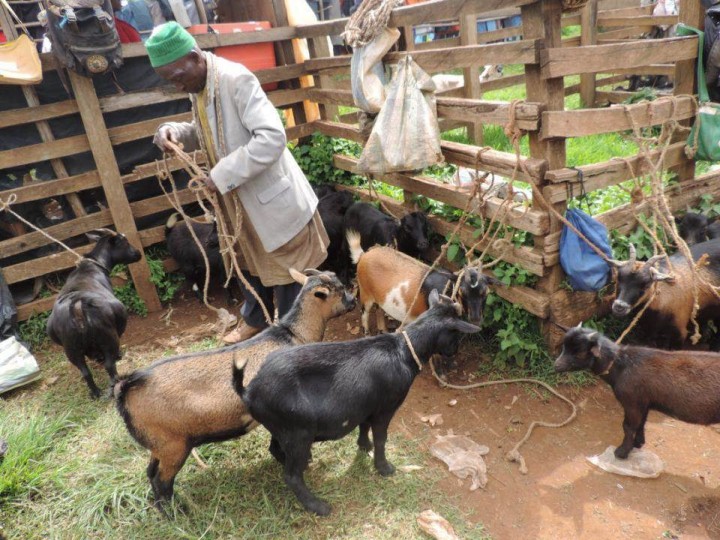
Cameroon’s economy is very underdeveloped. 70 percent of the country’s workforce is employed in agriculture, many of them using traditional farming methods
Corruption and foreign debt are major factors in Cameroon’s economic backwardness. Cameroon saw a huge amount of “capital flight” after achieving independence ($57bn between 1970 and 2012), with the bulk of that money being embezzled by government officials. This corruption (combined with a fall in oil prices) provoked a major economic crisis in the 1980s. Biya responded with massive cuts and privatisations in the public sector (amounting to an 18 percent reduction in government spending). He also accepted loans from the World Bank, the African Development Bank, France, Germany and the United Kingdom; as well as a £150m aid package from the IMF. From the 1990s onwards, Cameroon has taken on further loans, including a new economic and financial partnership agreement with the IMF in 2016.
All this accumulated debt has resulted in decades of hardship and misery for Cameroonians, who have been made to bear the burden of the economic crisis. In order to pay off its loans and meet the terms of its international lenders, the government has continued to restrict public spending. After the latest IMF package, Biya reduced domestic investment from 8 percent of GDP in 2016 to a projected 6.6 in 2019, which has only exacerbated long-standing social and infrastructural problems. Many roads are nigh-unusable, cuts to public education have considerably reduced the growth of literacy rates, and healthcare is of a very low quality. Moreover, despite an official unemployment rate of 4.4 percent, fewer than 18 percent of Cameroonian adults earn more than 200,000 FCFA ($400 USD) a month.
Meanwhile, Biya and high-ranking officials continue to leech off the state and enjoy lavish lifestyles at the public’s expense. Aside from his luxurious presidential palace in Yaoundé, Biya spends a great deal of time on “private trips” to the five-star Intercontinental Hotel in Geneva. This hypocrisy has only intensified the masses’ loathing towards the CPDM.
A new civil war?
The Anglophone question has cast a shadow over this election, with the majority of Cameroonians (65 percent) regarding it as the greatest threat to the country’s national security. English-speaking Cameroon has seen ever-deepening repression, along with centralisation of power to French-speaking Yaoundé under Biya’s presidency.
The Anglophone crisis cast a shadow over the election: a new civil war is on the cards in the southwest
A flashpoint came in 2016, when protest marches by Anglophone teachers and lawyers over the enforced use of French in classrooms and courts were met with gunfire from state troops that left 17 protestors dead. A ramping-up of tensions culminated in the declaration of the independent, Anglophone state of Ambazonia on 1 October 2017 by the Southern Cameroons Ambazonia Consortium United Front (SCACUF). Biya’s response was immediate and brutal. He shut down the internet in the southwest for a period of 93 days, and sent in American and Israeli-trained special forces (the Rapid Intervention Battalion or ‘BIR’) to quell the Anglophones. This has resulted in escalating skirmishes between Anglophone separatists and Biya’s troops, with hundreds dead already, thousands displaced, and accusations of atrocities on both sides (including the murder of women and children).
All the ingredients exist for a civil war on the southwestern border between Anglophone and Francophone Cameroon. With the memory of the Biafran War in neighbouring Nigeria still haunting many Cameroonians, this is a terrifying prospect. However, despite Biya’s attempt to lean on sectarian hatred against Anglophones, most of the country’s population (85 percent) are opposed to the government’s use of force in suppressing the separatists and believe that dialogue and negotiation should be pursued. It is clear that the Cameroonian masses have no taste for bloodshed, but with Biya still in power and no unifying class movement to cross language lines, any chance of a peaceful resolution appears remote.
The role of imperialism
Another factor explaining Biya’s grip on power is the support he receives from imperialist governments. His vicious handling of the Anglophone question has been met with a deafening silence from the west. In part, this is because the US has leaned on Biya and the Cameroonian military to help fight the Islamic terror group Boko Haram, who have a foothold in the north of the country. As a result, the United States has dished out more than $220m in military and security funding to Cameroon since 2012, via the State Department and the Pentagon. Cameroon has also historically represented one of the more stable governments and trading partners in the region. As such, aside from helping to arm and train Biya’s shock troops in the BIR, the Americans have also assisted Biya’s regime by continually rescheduling Cameroon’s debt obligations.
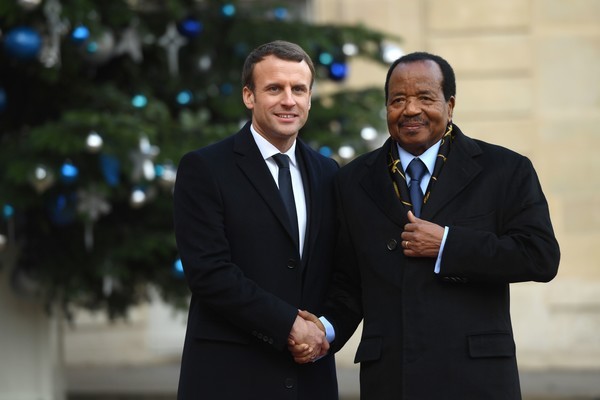
France remains the most important imperialist power in Cameroon, reflected in its strong support for Biya
However, France remains the most important imperialist power in Cameroon, reflected in its strong support for Biya in the 1992 elections, where the SDF nearly won the presidency. In that race, it is rumoured that French secret police fabricated incriminating documents linking SDF candidate Fru Ndi to illegal arms deals. Also, the French ambassador, Gilles Vidal, and other officials undertook a number of missions to one of the SDF’s few Francophone strongholds (the West Province) to ‘persuade’ the Bamileke elites to distance themselves from the SDF. The French also encouraged Biya to create satellite parties with Bamileke leaders so as to weaken local support for the SDF. It has even been alleged that France and the CPDM were conspiring to set up a Bamileke front in the SDF to create disorder within the party by playing on internal ethnic divisions.
The French rely on Biya and the CPDM to safeguard their exploitation of Cameroon’s rich natural resources. For more than 30 years, the French company Total controlled 75.8 percent of oil exploitation contracts signed via Cameroon’s state-run National Hydrocarbons Company (SNH). It also had shares in the National Refining Company (SONARA) and the Cameroon Oil Depots Company (SCDP). In 2010, Total sold its interests in Cameroonian oil to the Franco-British company PERENCO, which, today, is the leader in the exploitation and production of oil in Cameroon. Biya is more than content to allow these bloodsuckers to plunder his country’s oil reserves: so long as he and his cronies are compensated and maintained in power.
Imperialist exploitation of Cameroonian oil is also a major driving force behind the Anglophone question. Aside from state repression of the Anglophone identity, the English-speaking regions of Cameroon have provided the bulk of the country’s economic production, but see systematic under investment compared to the Francophone regions. In 2017, the two Anglophone regions were allocated a combined $153m of the country’s Public Investment Budget. Meanwhile the country’s south (Biya’s home region) was allocated more than $225m, despite having a far smaller population. Resentment towards this policy has fuelled the violent separatist movement.
The unions and the 2008 movement
Given all the anger and frustration from below, where is the political leadership of the working class? While Cameroon has a national trade union federation (the Confederation of Cameroon Trade Unions), it is a weak and corrupt body that has largely prostrated itself to the Biya regime. The most economically important layers of the Cameroonian working class – the oil workers in the southwest – are positioned around and off the coast, divided from the rest of the class. The most organised sector are the transport workers, who have provided some of the most resolute opposition to Biya’s authority in the last decade.
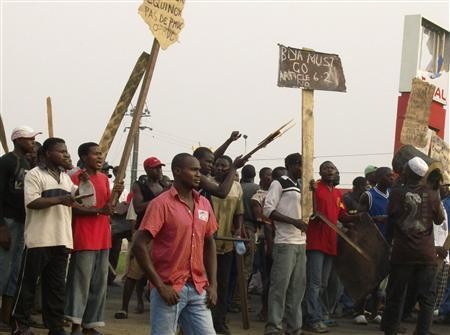
The 2008 anti-government protests cut across sectarian lines
By far the most important action by transport workers was a strike in February 2008, which provoked the most serious civil unrest since the 1990s. The dispute began with a strike on 25 February, ostensibly against extortionate parking fines and rising fuel prices. However, workers were also protesting against a planned constitutional amendment that would abolish presidential term limits, thus allowing Biya to run for office indefinitely. This was correctly identified as an attempt by Biya to ensure his rule for life, and the transport strike rapidly drew in very wide layers of the population (particularly the youth) enraged at this manoeuvre, amidst a list of other grievances. As Janet Garvey, then-US ambassador to Cameroon, commented:
“Frankly, the frustration of the people had boiled over… There was anger over the constitutional amendment, unemployment, corruption and a whole host of other problems… Both the Francophones and Anglophones were protesting.”
The movement was a reaction against the hated Biya regime and its imperialist backers, reflected in placards carried by demonstrators that read: “Biya must go,” “Down with France”, “No Life President.” It encompassed Anglophones, Francophones, Bassa, Bamileke, Ewondo, etc. and spread across 31 municipalities and half of the country’s provinces. By 26 February, a state of emergency was declared and Biya responded with a brutal clampdown that left 100 dead and resulted in 1,600 arrests. In the end, the leaders of the transport union confederation refused to provide a political leadership to the movement, and withdrew their support in exchange for very minor concessions.
Biya’s amendment passed on 10 April, leaving the youths who led the struggle severely demoralised. However, this was a highly significant event that showed the capacity for Cameroonians to transcend sectarian divisions and unify against the despised CPDM. All that was lacking was a working-class leadership to harness the energy from below, armed with a socialist economic programme capable of carrying out the people’s demands. Today, this essential ingredient is still lacking, but the urgent desire for change remains.
The need for a workers’ party
Despite achieving an overwhelming ‘victory’ in these elections, there is dynamite in the foundations of Biya’s regime. His repressive measures are a sign of weakness, not strength. As evidenced by his sending in riot police to lock down Douala and Yaoundé on the day the official results were released, he clearly fears the anger of the masses and has limited confidence in his own authority.
Decades of economic attacks and political repression against the Cameroonian working class and peasantry are bound to find their expression sooner or later, as in 2008. At some point the conditions suffered by the masses will produce a genuine, mass movement from below. This, in turn, could force Biya out of power. As we have seen in several African countries in the recent period, when the masses move in a decisive way, the regime is forced to remove the figurehead in the hope of holding back the movement. Biya’s mishandling of the Anglophone crisis could also lead to him being regarded as a liability by the bourgeoisie. Under these circumstances, he could go the way of Mugabe in Zimbabwe. For now he is stubbornly holding on to power.
Biya does not have the support of the masses, but they see no alternative. The masses do not support a civil war, but the situation is out of their hands. A workers’ party and movement are needed urgently
What has to be stressed is that the removal of one individual is not sufficient to solve the burning social and economic issues facing the Cameroonian masses. While the call for Biya to go can rally a large layer of the population, any meaningful, long-term solutions to Cameroon’s economic and political problems can only come from a socialist movement, capable of uniting the country’s various peoples and social layers on a class basis. For instance, while Marxists respect the right for democratic self-determination for the Anglophones, any separation based on ethnic or national lines that does not pose the problem in class terms, given the myriad of different tribal, ethnic and linguistic groups in the country, could result in a bloodbath. The shambolic opposition in these presidential elections demonstrates the necessity of a workers’ party – with a bold and clear political programme – to galvanise ordinary Cameroonians against Biya, the tribal elites and their imperialist masters.
It is evident that the CPDM does not have the support of the masses. It stays in power because right now the working masses see no alternative. Equally, they do not support a civil war in the southwest, but the situation is out of their hands, and rapidly spiralling out of control. The situation in Cameroon strongly poses the question: socialism or barbarism?
Source: Marxist.Com

